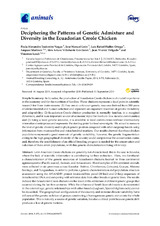Deciphering the Patterns of Genetic Admixture and Diversity in the Ecuadorian Creole Chicken
Autor
Toalombo, Paula Alexandra
León Jurado, J.M.
Fiallos Ortega, Luis Rafael
Martínez Martínez, Amparo
Villafuerte Gavilanes, Alex Arturo
Delgado-Bermejo, J.V.
Landi, Vincenzo
Editor
MDPIFecha
2019Materia
Creole chickenMicrosatellites markers
D-loop
Conservation
METS:
Mostrar el registro METSPREMIS:
Mostrar el registro PREMISMetadatos
Mostrar el registro completo del ítemResumen
Latin American Creole chickens are generally not characterized; this is the case in Ecuador, where the lack of scientific information is contributing to their extinction. Here, we developed a characterization of the genetic resources of Ecuadorian chickens located in three continental agroecosystems (Pacific coastal, Andean, and Amazonian). Blood samples of 234 unrelated animals were collected in six provinces across Ecuador: Bolívar, Chimborazo, Cotopaxi, Guayas, Morona Santiago, and Tungurahua, in order to perform a genetic characterization and population structure assessment using the AVIANDIV project microsatellites panel (30 loci) and D-loop sequences of mitochondrial DNA and comparing with reference data from other breeds or genetic lines. The results indicate that Ecuadorian Creole chickens are the result of the admixture of different genetic groups that occurred during the last five centuries. While the influence of South Spanish breeds is demonstrated in the colonial age, genetic relationships with other breeds (Leghorn, Spanish fighter cock) cannot be discarded. The geographical configuration of the country and extreme climate variability have influenced the genetic isolation of groups constituting a homogeneous genetic status into the whole population. This is not only a source of genetic variation, but also a critical point because genetic drift produces a loss of genetic variants.

